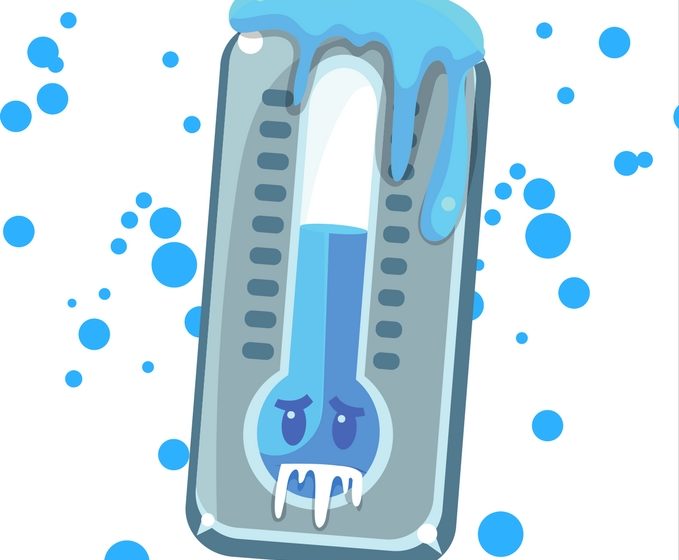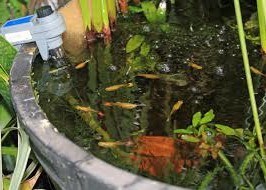
How to keep your fish and plants warm outdoors this Winter.
Patio ponds and other water features in containers are more susceptible to surrounding air temperatures than are in-ground ponds. If the night time minimum temperatures in your area will not drop below around 20 degrees Fahrenheit (or 7 degrees Celsius), then you have some options available to you.
It should be noted that none of these options will help much if temps drop below 0-10 degrees (-18 to -12 Celsius), short of bringing the whole container and contents inside for the Winter.
If you choose to bring your water feature inside it would be a good idea to consider investing in an inexpensive heat lamp and a timer. This way you can keep it out of the way inside the garage. A sunny window or a sun room is also a good option.
Container Fountains & Patio Ponds With A Fountain
Fountains provide movement in the water and will keep the surface from freezing when the air temperature drops down around 10-15 degrees below the freezing point. To keep the fountain head and pump from breaking and breaking remember to not exceed the manufacturer’s minimum operating temperature.
Any low-voltage fountain or bubbler should create enough movement to buy you a few more degrees below freezing than a water feature that does not have a fountain.
A Better Way To Over-Winter Container Ponds
Probably the best option short of bringing your container inside is to purchase a small submersible heater made for ponds and bird baths. This will help keep aquatic plants and fish a little warmer than the air outside. Look for a heater that can be mounted or clipped to the edge of the container.
Consider getting a heater with a thermostat so you won’t have to monitor the water temps. Be sure the heater you choose is rated for outdoor use. This excludes most aquarium heaters. Using a ground-fault circuit or G.F.C.I. protected outlet is recommended.

Caring For Aquatic Plants In The Colder Months
The minimum temperature requirements vary widely for aquatic plants. When uncertain about a particular variety, you can always Google “[your plant variety] hardiness zone” for more information.
As a general guideline, hardy varieties will over-winter better in cold climates than non-hardy aquatic plants. Tropicals fall into the non-hardy category.
Plant varieties that are not winter hardy would include water hyacinths, floating water lettuce, and tropical water lilies for just a few examples. If the night time temperatures get near or below freezing in your area you would treat these plants just like annuals, discarding when Winter hits and buying new ones the next year.
Floating lettuce and water hyacinths are cheap enough to buy each year and not really worth bothering with after the first frost. If you live below zone 8, you might want to bring more expensive plants indoors if they are not cold hardy.
Some aquatics will have some foliage damage but survive at the bottom of larger containers. An example of this would be a hardy water lily in a stock tank or whiskey barrel pond. The foliage at the surface may look damaged or dead but the plant may still be alive below the crown at the root level.
Plant Maintenance In Winter
You will want to remove any dead plant foliage from your container ponds if you find any. Decaying plants muck-up the water and can be harmful for fish.
As stated before, some aquatic plants may just look dead on the surface. If unsure, trim off any dead foliage down to the crown of the plant. The crown is the first couple of inches above the soil level. Cutting the crown off of plants such as hardy water lilies will kill the entire plant so just remember to leave some of the stem above the soil level un-trimmed.
Koi & Goldfish In Outdoor Containers
Ice on the surface of a container pond won’t harm goldfish, koi or most other pond fish. The problem is that a layer of ice will prevent oxygenation of the water and therefore no oxygen is available for the fish.
To prevent this it may be necessary on some mornings to break up this ice layer if it is thin enough to do so. For colder nights which produce a thick layer of ice a small submersible outdoor rated pond heater should do the trick.
There should always be a hole in the ice at least the size or diameter of a wine bottle. The larger your container pond is, the larger the hole should be also.
